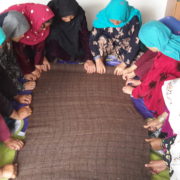This analytical piece is based on the author’s paper on “Women in Leadership” for Hult International Business School. For the full paper, please email [email protected]
The Grounded Theory of Women and Leadership in Afghanistan
According to the World Index, Afghanistan still “endures the first position as the worst place to be a woman in the world”(1) In general, 22% of decision-making roles are managed by women in government, 20% in private media, 24% in community development councils with 23 out of 102 seats in Meshrano Jerga and 68 out of 249 seats in Wolesi Jerga.(2)
Prejudice against women has been strongly rooted within the socio-economic contexts in Afghanistan while gender-based discrimination against women is an accepted principle.
Paradoxes Women Leaders Experience
- The common challenge of being a leader as a woman is to strive against stereotypes and assumptions, while men are ordinarily deemed to be in leadership positions. It is difficult to fit into a men dominant company as its organizational structure and rules are usually designed by men even if the company is owned by a woman.
- In terms of decision making, female leaders mostly get outwitted by men managers as they do not believe enough in women’s abilities. The usual belief is that female leaders make decisions based on feelings and emotions, which might lead to failure.
- Female leaders often constitute barriers to themselves by believing in stereotypes which eventually impacts their leadership style as a whole. They barely demonstrate their unique skills, creativity, and capabilities to bring change and be successful. Evidence shows that there would be a significant rise in leadership positions held by women if they get equal opportunity, more freedom, and more importantly, if they could overcome leadership stereotypes, which have been holding them back for centuries.
Succeeding as a Female Leader in a Male-Dominated Society
Self-determination is considered to be a superior factor for every woman to advance in their professional careers. Female leaders bring essential qualities to the workplace as they are empathic listeners who value teamwork and collaboration with extraordinary skills in building relationships and motivating others to reach their goals.
To be successful in a male-dominated environment, women have to understand the history, culture, values and complex ways to navigate the workplace. This indicates that women must know how to assess the environment from different perspectives.
Moreover, as men usually design the management structure even in industries created by women, women need to understand the unwritten rules by paying extra attention to the environment and individuals’ behavior at the workplace. For instance, women are not rewarded by their hardwork in the first place, however, they get judged by men and women by their looks and how they dress. Female leaders are generally expected to act differently than men and be more adaptable to what is expected, but yet get judged very quickly.
In reality, we are at least another decade away to grow from the surface and develop awareness of the dignity of women in the field, yet making the minimum effort will have a significant impression on the nation’s growth.
– Nargis Rahimi
Organizational culture and structure play a significant role in women’s careers. Women’s professional success can be influenced either negatively or positively based on the major individual and organizational factors rooted from social and cultural norms and stereotypes. These individual and organizational circumstances are mostly shaped by social norms expected of women to merely follow the rules. Thus, these expectations significantly modify different dimensions of female leadership characteristics.
For instance, no matter how hard women try, the traditional gender roles and stereotypes usually force women to act according to their so-called “Standard Roles.” Women, in general, experience more obstacles throughout their career path. It requires practicing intelligence and conscious leadership techniques to fight against stereotypes.
Women “considered to be shy” appears to be the most common one. To break this stereotype, women should speak up instead of holding their opinions back. It is crucial for women to show their skills and capabilities, identify a clear path for their personal and professional growth, and learn to manage their emotions. As a leader, they have to be able to communicate and articulate with confidence.
Female leaders constantly pay more attention to the perceived barriers than their potential, which makes them interact less with people and resist asking for favors. Yet, a meager number of women, who are willing to network may miss opportunities because they fail to understand the value of certain connections due to their closed mindedness. To learn more about the characteristics of a great female leader, aspiring women leaders must seek mentors. Women more likely think that being critical could strengthen their authority as a leader.
In contrast, this makes them seem more discouraging than supportive. When it comes to the workplace, it is essential to understand the importance of being supportive instead of promoting negativity. Intensifying one’s authority has been distinguished as a leader’s capacity for centuries, though it can be perceived as “Art of Doing Duties Strategically in Complex Environments.”
The Power of Women’s Leadership
Female leaders are more likely to have holistic thoughts, which makes them extra creative in solving complex problems and identify unique solutions.
Despite all the differences between men and women leaders, it is evident that female leaders always come up with unique approaches for implementing strategies in the workplace. They are as influential as men. Thus, by addressing the gender imbalance, companies and the governments can boost their performances.
The importance of female leadership has been illustrated by those who already hold key positions in organizations or governments. The fundamental characteristics that determine their leadership style include being persuasive, flexible, collaborative, people-oriented and sociable, creative, and having empathy and compassion. In reality, we are at least another decade away to grow from the surface and develop awareness of the dignity of women in the field, yet making the minimum effort will have a significant impression on the nation’s growth.
Note: “I believe the work we do today might not be very valuable in a few cycles from now, however; eternity belongs to the people we choose to work with today to reach the ultimate goals.” ■
____________________________________________________




